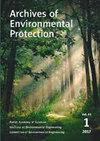Application of the FAPPS system based on the CALPUFF model in short-term air pollution forecasting in Krakow and Lesser Poland
IF 1.3
4区 环境科学与生态学
Q4 ENVIRONMENTAL SCIENCES
引用次数: 1
Abstract
: The aim of the study is to present the FAPPS (Forecasting of Air Pollution Propagation System) based on the CALPUFF puff dispersion model, used for short-term air quality forecasting in Krakow and Lesser Poland. The article presents two methods of operational air quality forecasting in Krakow. The quality of forecasts was assessed on the basis of PM 10 concentrations measured at eight air quality monitoring stations in 2019 in Krakow. Apart from the standard quantitative forecast, a qualitative forecast was presented, specifying the percentage shares of the city area with PM 10 concentrations in six concentration classes. For both methods, it was shown how the adjustment of the emissions in the FAPPS system to changes in emissions related to the systemic elimination of coal furnaces in Krakow influenced the quality of forecasts. For standard forecasts, after the emission change on June 7, 2019, the average RMSE value decreased from 23.9 μg/m 3 to 14.9 μg/m 3 , the average FB value changed from -0.200 to -0.063, and the share of correct forecasts increased from 0.74 to 0.91. For qualitative forecasts, for the entire year 2019 and separately for the periods from January to March and October to December, Hit Rate values of 5.43, 2.18 and 3.48 were obtained, the False Alarm Ratios were 0.28, 0.24 and 0,26, and the Probability of Detection values were 0.66, 0.75, and 0.74. The presented results show that the FAPPS system is a useful tool for modelling air pollution in urbanized and industrialized areas with complex terrain.基于CALPUFF模型的FAPPS系统在克拉科夫及小波兰地区短期空气污染预报中的应用
本研究的目的是提出基于CALPUFF烟雾扩散模型的空气污染传播预测系统(FAPPS),用于克拉科夫和小波兰的短期空气质量预测。本文介绍了克拉科夫空气质量预报的两种方法。预测的质量是根据2019年克拉科夫8个空气质量监测站测量的PM 10浓度进行评估的。除了标准的定量预测外,还提出了定性预测,指定了六个浓度等级的PM 10浓度在城市区域中的百分比份额。对于这两种方法,它都显示了FAPPS系统中的排放调整与克拉科夫系统消除煤炉相关的排放变化如何影响预测的质量。标准预报中,6月7日排放变化后,平均RMSE值从23.9 μg/ m3下降到14.9 μg/ m3,平均FB值从-0.200下降到-0.063,预报正确率从0.74上升到0.91。对于定性预测,2019年全年以及1 - 3月和10 - 12月的准确率分别为5.43、2.18和3.48,虚警率分别为0.28、0.24和0.26,检测概率分别为0.66、0.75和0.74。结果表明,FAPPS系统是模拟复杂地形下城市化和工业化地区大气污染的有效工具。
本文章由计算机程序翻译,如有差异,请以英文原文为准。
求助全文
约1分钟内获得全文
求助全文
来源期刊

Archives of Environmental Protection
ENVIRONMENTAL SCIENCES-
CiteScore
2.70
自引率
26.70%
发文量
0
期刊介绍:
Archives of Environmental Protection is the oldest Polish scientific journal of international scope that publishes articles on engineering and environmental protection. The quarterly has been published by the Institute of Environmental Engineering, Polish Academy of Sciences since 1975. The journal has served as a forum for the exchange of views and ideas among scientists. It has become part of scientific life in Poland and abroad. The quarterly publishes the results of research and scientific inquiries by best specialists hereby becoming an important pillar of science. The journal facilitates better understanding of environmental risks to humans and ecosystems and it also shows the methods for their analysis as well as trends in the search of effective solutions to minimize these risks.
 求助内容:
求助内容: 应助结果提醒方式:
应助结果提醒方式:


